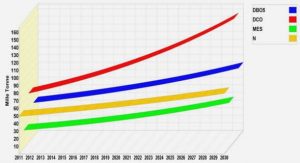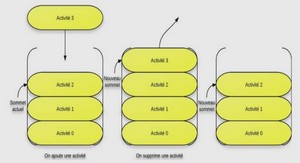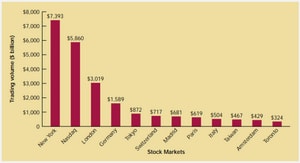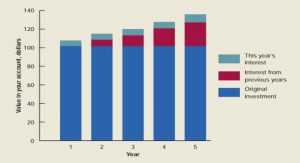Emergent Geometry and Gauge Theory in 4 Dimensions and The Noncommutative Torus
Yang-Mills Matrix
Theory Modern particle theories, such as the Standard model, are quantum YangMills theories. In a quantum field theory, space-time fields with relativistic field equations are quantized and, in many calculations, the quanta of the fields are interpreted as particles. In a Yang-Mills theory these fields have an internal symmetry: they are acted on by a space-time dependant nonAbelian group transformations in a way that leaves physical quantities, such as the action, invariant. These transformations are known as local gauge transformations and Yang-Mills theories are also known as non-Abelian gauge theories. Yang-Mills theories, and especially quantum Yang-Mills theories, have many subtle and surprising properties and are still not fully understood, either in terms of their mathematically foundation or in terms of their physical predictions. However, the importance of Yang-Mills theory is clear, the Standard Model has produced calculations of amazing accuracy in particle physics and, in mathematics, ideas arising from Yang-Mills theory and from quantum field theory, are increasingly important in geometry, algebra and analysis. Consider a complex doublet scalar field φa ; a scalar field is one that has no Lorentz index, but, as a doublet, φa transforms under a representation of SU(2), the group represented by special unitary 2 × 2 matrices: φa(x) → gabφbx (3.1) where g ∈ SU(2) and the repeated index is summed over. If this is a global transformation, that is, if g is independent of x, then derivative of φa have 53 the same transformation property as a itself: ∂φa ∂xµ → ∂gabφb ∂xµ = gab ∂φb ∂xµ + ∂gab ∂xµ φb (3.2) In order to construct an action which includes derivatives and which is invariant under local transformations, a new derivative is defined which transforms the same way as φa : Dµφa = ∂φa ∂xµ + (Aµ)abφb (3.3) where Aµ is a new two-indexed space-time field, called a gauge field or gauge potential, defined to have the transformation property (Aµ)µ → gab(Aµ)cdg −1 db − ∂gac ∂xµ g −1 cb (3.4) Now, under a local transformation Dµφa → gabDµφb (3.5) and so, Dµφa transforms in the same way as φa . This derivative is called a covariant derivative. A physical theory which includes the gauge field A should treat Aµ as a dynamical field and so the action should have a kinetic term for Aµ . In other words, the action should include derivative terms for Aµ . These terms are found in the field strength Fµν = ∂Aν ∂xµ − ∂Aµ∂xν + [Aµ, Aν] (3.6) which has the covariant transformation property (Fµν)ab → gab(Fµν)cdg −1 db (3.7) where [Aµ, Aν] is the normal matrix commutator. In fact, the simplest YangMills theory is pure Yang-Mills theory with action S[A] = − 1 2 Z d 4x trace FµνF µν . (3.8) and corresponding field equation ∂Fµν ∂xµ = 0 (3.9) 54 Solutions to this equation are known as instantons. More generally, Yang-Mills theories contain gauge fields and matter fields like φ and fields with both group and Lorentz or spinor indices. Also, the group action described here can be generalized to other groups and to other representations. In the case of the Standard Model of particle physics, the gauge group is SU(3)×SU(2)× U(1) and the group representation structure is quite intricate. Yang-Mills theory was first discovered in the 1950s, at this time, Quantum Electrodynamics was known to describe electromagnetism. Quantum Electrodynamics is a local gauge theory, but with an abelian gauge group. It was also known that there is a approximate global non-Abelian symmetry called isospin symmetry which acts on the proton and neutron fields as a doublet and on the pion fields as a triplet. This suggested that a local version of the isospin symmetry might give a quantum field theory for the strong force with the pions fields as gauge fields [ORaifeartaigh, 1997]. This did not work because pion fields are massive whereas gauge fields are massless and the main thrust of theoretical effort in the 1950s and 1960s was directed at other models of particle physics. However, it is now known that the proton, neutron and pion are not fundamental particles, but are composed of quarks and that there is, in fact, a quantum Yang-Mills theory of the strong force with quark fields and gauge particles called gluons. Furthermore, it is now known that it is possible to introduce a particle, called a Higgs boson, to break the non-Abelian gauge symmetry in the physics of a symmetric action and give mass terms for gauge fields. This mechanism is part of the Weinberg-Salam model, a quantum Yang-Mills theory of the electroweak force which is a component of the Standard Model and which includes both massive and massless gauge particles. These theories were only discovered after several key experimental and theoretical breakthroughs in the late 1960s and early 1970s. After it became clear from collider experiments that proton have a substructure, the oretical study of the distance dependant properties of quantum Yang-Mills theory lead to the discovery that Yang-Mills fields are asymptotically free [Gross, 1999]. This means that the high-energy behaviour of Yang-Mills fields includes the particle like properties seen in experiments, but the low-energy behaviour may be quite different and, in fact, the quantum behaviour might not be easily deduced from the classical action. Confinement and the mass gap are examples of this. The strong force is a local gauge theory with quark fields. The quark structure of particles is observed in collider experiments, but free quarks are never detected, instead, at low-energies, they appear to bind together to form composite particles, such as neutrons, protons and pions. This is called confinement. It is possible to observe this behaviour in simulations of the quantum gauge theory of the strong force, but it has not been possible to prove mathematically that confinement is a consequence of the theory. The same is true of the mass gap, it is known that particles have non-zero mass, and this is observed in simulations, but, there is no known way of deriving the mass gap mathematically from the original theory [Clay, 2002]. The symmetries of Yang-Mills theory can be extended to include a global symmetry between the bosonic and fermionic fields called supersymmetry. While there is no direct evidence for supersymmetry in physics, the indirect case is very persuasive and it is commonly believed that direct evidence will be found in the future. Often, supersymmetric theories are more tractable, for example, Seiberg and Witten have found exact formula for many quantum properties in N = 2 super-Yang-Mills theory [Seiberg , Witten 1994]. It is also commonly believed by theoretical physicists that the quantum YangMills theories in particle physics are in fact a limit of a more fundamental string theory.
Yang-Mills Theory in Low Dimensional
Bosonic Matrix Integrals
We begin our systematic study of Yang-Mills theories on low-dimensional with the simplest possible example, namely 0-dimensional Yang-Mills coupled to p adjoint scalars with a quartic interaction. There are no Yang-Mills fields in 0-dimensions and the effect of gauging is trivial, introducing only an overall factor of the gauge group volume. As a result, the partition function that we wish to study takes the form of a simple matrix integral Z = Z D Φiexp − N 2λ0 trX i m2 i Φ 2 i − X i> 1 The second regime that one can study corresponds to the limit of large mass m >> 1 and displays a much more interesting and nontrivial structure. Here, the theory is effectively weakly coupled and, since all mode except the zero component of the gauge field, A0 , are massive, they can be integrated out in perturbation theory. We consider a function of a unitary matrix U Z = Z DUexp[−N 2Seff(U) ] U = e i H dtA0 (3.14) The computation of Sef f (U) now proceeds exactly as in the N = 4 theory with the identification x = e −MR = e −m/t˜ , (3.15) the letter partition function is rather trivial as there is only one bosonic state at energy 1 for each scalar field z(x) = x (3.16)
YANG-MILLS THEORY IN LOW DIMENSIONAL
This leads to a simple effective action for U Seff(U) = p X∞ n=1 x n n tr(U n )tr(U −n ) (3.17) where the factor of p arises because Sef f receives contributions from p scalar fields. Writing this in terms of moments ρn of the corresponding eigenvalue distribution, this becomes Seff(ρn) = X∞ 1 1 n m2 n |ρn| 2 (3.18) m2 n = 1 − pxn (3.19) where the 1 in (3.19) arises from the Vandermonde measure as usual. t˜c = m(ln p) −1 (3.20) Away from the strict m → ∞ limit, (3.18) will receive corrections that can potentially alter the order of the transition. In particular, as we have seen many times it is the sign of the quartic term in the effective potential for ρ1 that is the difference between first and second order. This can be determined by computing higher-loop perturbative corrections to (3.18) and integrating out the modes ρi with i > 1 that remain massive at the transition point. The result is an effective potential for ρ1 S(ρ1) = m2 1 (x, m−3 |ρ1| 2 + 1 m6 b(x, m−3 )|ρ1| 4 + … (3.21) The calculation of m1 and b to the requisite orders is straightforward but tedious, yielding [66] m2 1 = (1 − px) − 1 4m6 (p 2 − p)(x 2 + 2x)lnx (3.22) b = − 1 32 (p − 1)lnp p 3 (ln(p)(9p 2 + 2p) + 4p 3 + 7p 2 − 4p − 4)m−6 + … Since b < 0 for all p > 1, we see that the phase transition is indeed of first order as one moves away from m = ∞. From the correction to m2 1 in (3.23), we can also compute the leading order shift in the phase transition temperature, obtaining [66] t˜c = m(lnp) −1 + 1 4m2 (p − 1)(2p + 1) plnp + … (3.23) This result will fit in nicely the picture of the m = 0 theory that we now describe. 3.1.3 Bosonic Yang-Mills on T 2 We now consider the first of our two-dimensional models, namely bosonic Yang-Mills on a rectangular two-torus with radii R1, R2 The specific model that we consider has action S = N 2λ Z d 2 xtr F 2 12 + X p i=1 (DµΦ I ) 2 + M2Φ 2 I − X I>J [ΦI , Φ J ] 2 (3.24) and can be parametrized by the two dimensionless radii r1 = R1 √ λ r2 = R2 √ λ (3.25) and the dimensionless mass m = M √ λ (3.26) Infinite masses m = ∞ We begin our study of (3.24) by considering the strict limit m = ∞. The reason we do this is to recall some elementary facts about the exact solution of pure Yang-Mills on a two-torus that will be useful when we study large but noninfinite masses. The exact result for the two-dimensional Yang-Mills partition function was first obtained by Migdal [67] using a lattice regularization of the theory. We consider putting unitary matrices UL on the links of the lattice and consider the partition function Z = Z Y L DUL Y P ZP (UP ) (3.27) where the product is over plaquettes P of the lattice and ZP is a plaquette action chosen so that the continuum theory coincides with Yang-Mills. One example of a plaquette action is the usual Wilson one ZP = exp N λ tr(UP + U −1 P ) (3.28) One can imagine integrating out some of the links to generate an effective action for the larger plaquettes that remain. Under this RG flow, the action (3.28) is not invariant, instead flowing to the plaquette action [67] ZP (UP ) = X R dRχR(UP )exp − λA 2N C2(R) (3.29) where the representation R has dimension dR and quadratic Casimir C2(R) and A is the area of the new plaquettes in units of the fundamental ones. It is easy to verify that (3.29) satisfies the additivity property Z DUZP (V1U, A1)ZP 0(U †V2, A2) = ZP +P 0(V1V2, A1 + A2) (3.30) and consequently is an RG fixed point. To compute the partition function of 2-dimensional Yang-Mills, we are equally justified in using (3.28) or (3.29). The former is easier to work with as the property (3.30) can be used to integrate out all of the links except those wrapping nontrivial cycles. Restricting to the torus for simplicity, we arrive at the following expression for the partition function Z = Z DUDV X R dR exp(− r1r2 2N C2R)χR(UV U −1V −1 ) (3.31) where we have used the definitions (3.25) of r1, r2 . The links which remain are precisely the holonomies that we wish to study. The remaining integrals (3.31) are now sufficiently simple that we can perform them exactly to obtain Z = X R e − r1r2 2N C2(R) (3.32) This partition function is very well-behaved and exhibits no nontrivial phase structure. As an exercise, let us obtain this conclusion in a manner more in line with the sort of analysis that we have used to study other theories above. In particular, let us consider integrating out only one holonomy, say V , from (3.31). We obtain Z = Z DU X R e − r1r2 2N C2(R)χR(U)χR(U † ) (3.33) Using the generalized Frobenius relations of [68], [69], [70] it is possible to write the integrand in terms of an effective action for U [67] Z = Z DUexpX n 1 n (−e −r1r2n + 2e −r1r2n/2 )tr(U n )tr(U −n ) (3.34) Introducing an eigenvalue density ρ as usual, we can obtain an effective action for the moments of ρ Sef f (ρn) = X n 1 n (1 − e −r1r2n/2 ) 2 |ρn| 2 (3.35) We see that for all values of the coupling λA = r1r2 the effective masses of the ρn are positive. In the limit r1r2 → ∞ they become arbitrarily light but the never become tachyonic. The eigenvalue distributions are thus always uniform and there is no phase transition.
1 Introduction and Summary |





